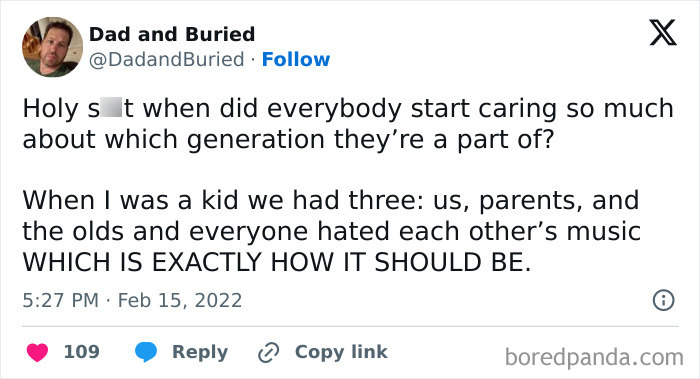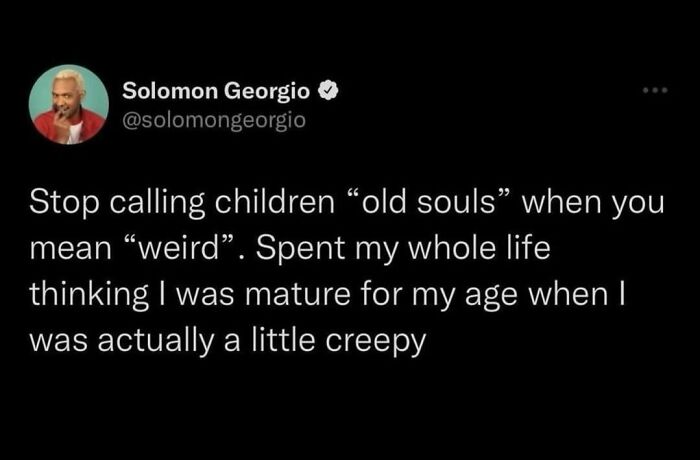Scrolling through memes can be a great way to unwind after a long day. But sometimes, you come across one that makes you pause, stare a little blankly, and then let out a sigh—a good kind of sigh, of course. You know the ones—the memes that are so utterly nonsensical, so weirdly relatable, or just plain strange that they leave you with a goofy grin.
There’s a popular Instagram page called Themuffreport dedicated to sharing exactly those kinds of mind-numbing memes. We’ve combed through their posts and picked out some of their funniest ones for you to enjoy. Scroll down to check them out and upvote your favorites!
#1

Image credits: DadandBuried
Themuffreport has over 900k followers, and it’s not surprising—the internet loves memes that have a hint of weird or are a bit ironic. It feels like those of us who spend our lives online have developed a taste for the absurd. But why do we find things funny, especially nonsensical ones?
Peter McGraw, a professor of marketing and psychology at the University of Colorado Boulder, explores this idea in his book The Humor Code: A Global Search for What Makes Things Funny, which he wrote with journalist Joel Warner.
There are several theories about what makes us laugh, but McGraw, along with Caleb Warren, an associate professor of marketing at the University of Arizona, came up with one that covers it all: the benign violation theory. As McGraw explains, “People laugh at, they’re amused by, they judge something as funny if it is simultaneously wrong yet okay, threatening yet safe, doesn’t make sense yet makes sense.”
#2

Image credits: FitFounder
#3

Image credits: themuffreport
“You can imagine kind of a Venn diagram, an overlap, between benign and violation,” McGraw elaborates on the theory. “What happens is the violation gives us arousal, makes us concerned, and then what we call the benign appraisal, seeing how this is okay, flips it and turns it from bad to good and we laugh to tell the world this thing that seems so threatening is actually harmless.”
#4

Image credits: themuffreport
#5

Image credits: themuffreport
McGraw and Warren tested their framework in various settings. In one study for a 2010 research paper, they asked University of Colorado students whether certain statements made them laugh.
One passage that respondents found both wrong and funny was: “Before he passed away, Keith’s father told his son to cremate his body. Then he told Keith to do whatever he wished with the remains. Keith decided to snort his dead father’s ashes.” The violation here, of course, is the snorting of the ashes. But the benign part is that Keith’s dad had said he could do whatever he wanted with the remains, making it technically okay.
#6

Image credits: themuffreport
#7

Image credits: themuffreport
#8

Image credits: themuffreport
The benign violation theory doesn’t suggest that jokes have to be extreme to be funny. However, it does explain how they can fall short—they can be too benign or too much of a violation. “Dad jokes, when they’re not funny, are rarely ever offensive. They fall on the boring side of the continuum,” McGraw points out. “But there are a lot of jokes that are very risqué and when those jokes fail, people are offended. They’re outraged.”
#9

Image credits: themuffreport
#10

Image credits: themuffreport
#11

Image credits: themuffreport
Ultimately, a person’s perspective on what they consider right or wrong determines if they find something funny, and this is highly individual. “There’s very little that’s universal when it comes to comedy, to be honest,” notes McGraw.
What someone views as benign or a violation is influenced by many factors—their beliefs, lifestyle, the number of drinks they’ve had, the context they’re in, whether they’re in a comedy club or a church, and naturally, their culture, because culture creates norms and rules. “A lot of comedy breaks rules, so it depends on what rules you value and don’t value in that way.”
#12

Image credits: NicoleCLindsay
#13

Image credits: themuffreport
#14

Image credits: themuffreport
Sometimes, timing can play a crucial role. McGraw once conducted a study to see how long it would take for people to start laughing at something tragic. “The amount of time depends on a lot of things, including how big a violation it is,” he says. “But as a result of that work, we revised the idea that comedy is tragedy plus time to be comedy is tragedy plus the right amount of time.”
There are many topics that are initially too sensitive to joke about, but after a while, they become acceptable. However, if too much time passes, they might no longer be relevant or funny. The key is finding that “sweet spot” when the timing is just right.
#15

Image credits: caitiedelaney
#16

Image credits: themuffreport
#17

Image credits: themuffreport
Why is it that time helps make something funnier? “Because the passage of time creates distance from it, and distance, whether it be the passage of time or physical distance or relational distance, helps turn violations into benign violations by removing their threat,” McGraw reasons.
For example, in that study, his team measured people’s reactions to a parody account of Hurricane Katrina. “What we found was as Katrina was wreaking havoc on the New York metropolitan area, the jokes coming out of this parody account weren’t funny. Then, with the passage of time, they started to become funny and less offensive. And then further, months and months later, those jokes no longer seemed relevant,” McGraw recalls.
“I can’t remember the exact date but it was like 39 days after Hurricane Katrina we found that those jokes peaked. Of course, in some cases, it peaks an hour later. [...] And there are some tragedies in the world that may never peak because it never becomes okay to joke about.”
#18

Image credits: simoncholland
#19

Image credits: themuffreport
#20

Image credits: themuffreport
Although humor is very personal, some things are more likely to resonate with a wide range of people. “The most universal [one] is physical comedy. That is, on the individual level, things like tickling and play-fighting,” says McGraw. We know this because non-human primates laugh when they play-fight. And if you search the internet for “rat laughter,” you can even find videos of rats being tickled and laughing in their own way.
#21

Image credits: themuffreport
#22

Image credits: AaronChewning
#23

Image credits: themuffreport
A classic example of physical comedy that most people recognize is someone slipping on a banana peel. When they fall, it instantly makes us worry about their safety. But if they get up and dust themselves off, the situation becomes light-hearted—and that’s what makes it funny.
“That’s as close as we come because there are no cultural norms, there is no language, and it all is connected to that idea of physical play,” McGraw sums up. “But as you know, not everybody finds pratfalls to be amusing, so there are real limits to the universality of comedy.”
#24

Image credits: themuffreport
#25

Image credits: themuffreport
#26

Image credits: themuffreport
McGraw’s research shows us that it’s perfectly normal to find humor in unusual things. Whether it’s a silly pratfall or a questionable meme, these moments bring us joy and relief. So, embrace the absurdity and enjoy the jokes that brighten your day.
#27

Image credits: themuffreport
#28

Image credits: themuffreport
#29

Image credits: themuffreport
#30

Image credits: themuffreport
#31

Image credits: themuffreport
#32

Image credits: themuffreport
#33

Image credits: themuffreport
#34

Image credits: themuffreport
#35

Image credits: themuffreport
#36

Image credits: themuffreport
#37

Image credits: themuffreport
#38

Image credits: themuffreport
#39

Image credits: themuffreport
#40

Image credits: themuffreport
#41

Image credits: themuffreport
#42

Image credits: themuffreport
#43

Image credits: themuffreport
#44

Image credits: themuffreport
#45

Image credits: themuffreport
#46

Image credits: themuffreport
#47

Image credits: themuffreport
#48

Image credits: themuffreport
#49

Image credits: themuffreport
#50

Image credits: themuffreport







